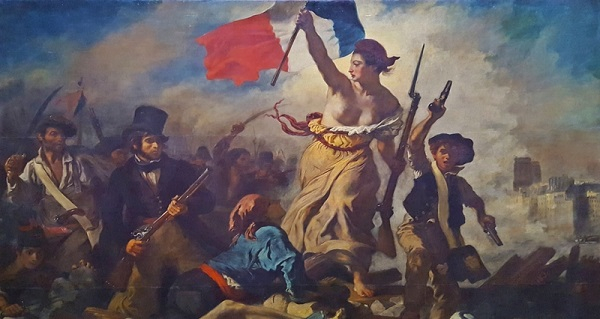

The French population was significantly impacted by the American Revolt, which was a large determinant in the French Revolution's manifestation. The American Revolution set a high benchmark by offering revolutionary thoughts and diverse approaches to administer a civilization. The British Monarchy's continued tyranny was indeed the foundation of their revolt. Despite all difficulties, the Americans remained effective in obtaining liberty. However, the French Monarch, King Louis XVI, fought jointly until it came to collapsing the British Monarchy, which was crucial to the achievement of their independence. The American Revolution's financial assistance led to a political crisis and substantial debt, which acted as an igniter of the French Revolution.

Liberty Leading the People by Eugène Delacroix: an allegorical painting of the July Révolution 26-29 Jully 1830. Exhibit at the Louvre Museum
The American Revolution became the battle that culminated in the 13 American colonies of Great Britain obtaining their sovereignty. The United States was founded from the original colonies. The revolution spanned from 1775 to 1783.
When the Military of the Original 13 colonies was constituted in June 1775, French assistance in the American Revolutionary War (1775-1783) commenced in 1776 once France discreetly delivered supplies to it.
In 1778, the American Military and the French signed a Treaty of Alliance. It resulted in the French sending supplies, troops, and money to the U. S. After the Declaration of Liberation, the French nobility and the broad public both welcomed the American Revolution. George Washington's escape from the British assault in 1776 and 1777 was supported by France.
American vessels that operated in robbery targeting British merchant ships, from the Continental Navy, parked up at French ports. France gave economic help in the form of grants or loans, and technical cooperation, permitting military strategists to take “vacations” to support American forces.
A naval assault attempt during the Siege of Savannah, which involved about 3,000 French and 2,000 Americans, collapsed. Support gained prominence after the year 1780 and 6,000 men under Rochambeau set up a naval station at Newport, which the British had deserted in 1779. In 1781, French military experts, at last, decided that additional huge companies in North America would be necessary to put an end to the fighting.
The American Revolution was the first effective fight for liberty in modern history, which makes it an extraordinary accomplishment. It acted as a template for all succeeding independence struggles throughout the 19th and 20th centuries in various regions of the world. Surprisingly, the American fight for independence served as a major source of inspiration for the Indian freedom conflict. The Indian nationalist leadership was motivated mainly by the hardships faced by George Washington and Thomas Jefferson.
The American Revolution is symbolised as an amazing victory for anti-colonialist movements. British colonialism in the colonies was eliminated by the Americans. The entirety of the various departments of the American government's authority, positions, and responsibilities would originate from this. Additionally, the constitution assumed possession of personal liberty, civic rights, and democracy. The victory of the Revolution allowed the colonists to provide their political viewpoints, as stated in the Declaration of Independence.
The status of France's economy was horrible. Following the several wars in which France had participated, the treasury was empty. The economic and political difficulties in France could not be handled by King Louis XVI.
France's political and social system became frustrating. In French society, there were three estates or classes. The first and second domains were afforded many privileges by the government and paid no taxes.
The French individuals were motivated to oppose their domination by the aristocracy, religion, and the state as a response to the Americans' victory in their struggle for freedom.
With their innovative concepts of fairness and equality, French philosophers Voltaire, Rousseau, and Montesquieu encouraged the masses. In “Social Contract,” Rousseau claimed that common will was the root of sovereign authority.
The Revolt created a substantial influence on the daily livelihood of the women who lived in the newly produced United States of America. The existence of black individuals, whether they were slaves or independent, was significantly impacted by the Revolution. It promoted western expansion and established governments unfriendly to their territorial sovereignty.
After liberation, both social and political life witnessed a major transition. As soon as the number of ordinary citizens who may vote grew, and hence did political activity intensified. Additionally, the presence of more regular people in both local and state administration increased.
The Revolution's most noteworthy long-term monetary consequence has been the collapse of mercantilism. The British Colony had enforced significant constraints on the colonial economic system, particularly trade restrictions, immigration, and manufacturing. The American triumph also enabled them to expand and conquer the western provinces, introducing new domestic businesses.
The French people were hugely affected by the American Revolution, which was a significant factor in the French Revolution's development. The American Revolution's financial support for the American Revolution resulted in political instability and massive debt at the start of the French Revolution. The sense of liberty and personal rights which the American colonists struggled for inspired the French to fight and establish numerous events. In addition, by helping the French government to go bankrupt, it popularized democratic ideas.
Q1. What parameters influence both the French and American Revolutions?
Ans. Countless dramatic uprisings unfolded in both the European and American Colonies throughout the Revolt. The French and American Revolutions were highly altered by theories that arose during the Enlightenment era.
Q2. What are the common features of the French and American Revolutions?
Ans. The objective of the American and French Revolutions was to provide the people with liberty and equality. Both countries were striving to put an end to their insurrection.
Q3. What variations did the American Revolution create from the French Revolution?
Ans. This idea differs from the American revolutionaries' perspective. The French followed rationality, while their desires led the Americans.